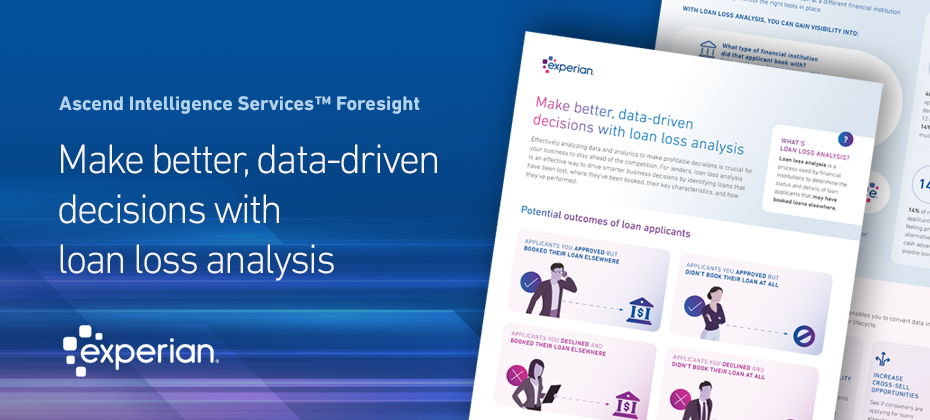Tag: loan

Loan loss analysis helps financial institutions identify the characteristics and performance of loans that have been lost to competitors.

Electric vehicle (EV) registrations are re-gaining momentum as a wave of more affordable models hit the market, pushing more consumers than ever to make the transition. According to Experian’s State of the Automotive Finance Market Report: Q3 2024, EVs made up 10.1% of new vehicle financing this quarter, increasing more than 30% from last year. Furthermore, 45% of EV consumers leased their vehicle in Q3 2024—resulting in EVs accounting for 17.3% of all new vehicle leasing. Of the top five transacted EV models this quarter, Tesla accounted for three—with the Tesla Model Y leading at 31.8%, followed by the Tesla Model 3 (14.3%) and Tesla Cybertruck (4.9%). Rounding out the top five were the Ford Mustang Mach-E (3.9%) and Hyundai IONIQ 5 (3.7%). Interestingly, data in the third quarter of 2024 found that consumers’ financing decisions vary based on the EV model they’re looking at. For example, 76.5% of consumers purchased the Tesla Model Y with a loan and 13.1% opted for a lease; on the other hand, only 8.5% of consumers bought the Hyundai IONIQ 5 with a loan and 78.7% chose to lease. Despite the rising interest in leasing as more incentives and rebate programs roll out, some consumers still prefer to purchase their EV with a loan. Understanding financing patterns based on different models is key for professionals as they cater to the diverse preferences and determine the long-term viability of certain EVs and their potential for leasing renewals. Snapshot of the overall vehicle finance market As the finance market continues to stabilize, it’s notable that the average interest rate for a new vehicle fell year-over-year, going from 7.1% to 6.6%, respectively. However, average new vehicle loan amounts increased $736 from last year, reaching $41,068 in Q3 2024, and average monthly payments went from $732 to $737 in the same time frame. On the used side, average interest rates saw a slight uptick to 11.7% in Q3 2024, from 11.6% last year. Meanwhile, the average loan amount dropped from $1,195 over the last year to $26,091 this quarter and the average monthly payment declined from $538 to $520 year-over-year. With the overall market shifting and EVs re-sparking interest, automotive professionals should leverage how consumers are purchasing their vehicles based on average payments and the fuel type as more incentives are being offered. Monitoring these insights can unlock opportunities for tailored financing solutions that meet the needs of consumers as preferences continue to evolve. To learn more about automotive finance trends, view the full State of the Automotive Finance Market: Q3 2024 presentation on demand.

Student loan forbearance, part of the Coronavirus Aid, Relief, and Economic Security (CARES Act) economic stimulus bill that paused student loan repayment, interest accrual, and collections, is set to expire on May 1, 2022. Borrowers who carry federal student loans in the United States need to anticipate the resumption of repayment and interest accrual. In this article, we’ll answer questions your borrowers will be asking about the end of the student loan pause and how they can better prepare. Lenders and servicers should anticipate an influx of requests for modification and for private student loan lenders, a potential significant push for refinancing. When do student loans resume and when does student loan interest start again? Student loan repayments and resumption of interest accruals are set to resume on May 1, 2022. This means that student loans will start accruing interest again, and payments will need to resume on the existing payment date. In other words, if the due date prior to the pause was the fifth of every month, the first repayment date will be May 5, 2022. In the weeks preceding this, borrowers can expect a billing statement from their student loan servicer outlining their debt and terms or they can reach out to their servicers directly to get more information. Will student loan forbearance be extended again? Will the CARES Act be extended? There is no indication that the federal government will extend student loan forbearance beyond May 1, 2022, which was already extended beyond the original deadline in February 2022. Your borrower’s best strategy is to prepare now for the resumption of repayments, interest accrual and collections. Will Biden forgive student loans? Free community college tuition and federal student loan forgiveness up to $10,000 were a centerpiece of the Biden platform during his candidacy for president and were included in early iterations of the government's Build Back Better agenda. In February 2022, during bargaining, the administration removed the free tuition provision from the bill. The Build Back Better bill has yet to pass. Although there remains a student loan relief provision in the draft Build Back Better agenda, there is no guarantee that it will make it into the final iteration. What should borrowers do if they paid student loans using auto-debit? Most borrowers will need to restart auto-debit after the student loan pause. If auto-debit or ACH was used prior to the student loan pause went into effect on March 13, 2020, borrowers can expect to receive a communication from their servicer confirming they wish to continue with auto-debit. If the borrower doesn’t respond to this notice, the servicer may cancel auto-debit. If the borrower signed up for auto-debit after the beginning of forbearance, payments should automatically begin. How much interest will borrowers have to pay? Unless terms have changed, such as consolidating loans, the interest rate will be the same as it was before the student loan pause went into effect. Will balances be the same as they were before the student loan pause? Will it take the same amount of time to pay off the student loan? For those on a traditional repayment plan, a student loan servicer might recalculate the amount based on the principal and interest and the amount of time left in the repayment period. Borrowers will still make payments for the same number of months in total, but the end date for repayment will be pushed forward to accommodate the payment pause. In other words, if the loan terms originally stated that it would be repaid in full on January 1, 2030, the new terms will accommodate the pause and show full repayment on January 1, 2032. For those on an Income-Driven Repayment Plan (IDRP) – such as Revised Pay as You Earn Repayment (REPAYE), Pay As You Earn Repayment (PAYE), Income-Based Repayment (IBR), or Income-Contingent Repayment (ICR) – the payment amount will resume at the same rate as before the payment pause. Student loan forbearance will not delay progress towards repayment. What are borrower options if the student loan payment is too high? Enroll in an IDRP program: Available plans include REPAYE, PAYE, IBR or ICR. Student loan refinancing: When a borrower refinances, he or she can group federal and private loans and possibly negotiate a lower repayment amount. However, they will not be eligible to access federal loans protections or programs. Loan consolidation: This process allows borrowers to combine multiple federal loans into a single loan with a single payment, which can reduce monthly payments by extending the repayment period. Note this will result in more interest being charged, as the time to repay will be extended. Will this change affect those with private student loans? Private lenders are not covered by the CARES Act, so student loan forbearance did not apply to them. Most private lenders have continued collecting repayments throughout the COVID-19 pandemic. Borrowers having trouble making payments to a private lender, can discuss options such as deferment, forbearance, consolidation and modified repayment terms. What happens if a student loan payment is missed or the borrower can’t pay at all? If a payment is missed, the account will be considered delinquent. The account becomes delinquent the first day after a missed payment and remains that way until the past-due amount is paid or other arrangements are made. If the account remains delinquent, the loan may go into default. The amount of time between delinquency and default depends on the student loan servicer. If the loan goes into default, borrowers could face consequences including: Immediate collections on the entire loan and interest owed Ineligibility for benefits such as deferment and forbearance, Inability to choose a different payment plan or obtain additional federal student aid Damage to credit score Inability to buy or sell assets Withholding of tax refunds or other federal benefits Wage garnishment A lawsuit Do student loans affect credit scores? Yes, for delinquent student loans, the servicer will report the delinquency to the three major credit bureaus and the borrower’s credit score will drop.2 A poor credit score can affect a consumer’s ability to obtain credit cards or loans and may make it difficult to sign up with utilities providers, cell phone providers and insurance agencies. It can also be challenging to rent an apartment. What are the options for those who can’t pay? Can student loans be deferred? For those with federal student loans, now is the time to prepare for the end of student loan forbearance. Revisit budgets, make sure records are up to date and communicate with student loan servicers to make sure payments can be made in full and on time. For those unable to pay back loans, they can consider requesting a deferment. A deferment is a temporary pause on student loan payments. Depending on the type of loan, interest may or may not continue to accrue during the deferment. If they wish to apply for a deferment, they must meet eligibility requirements. Some common grounds for deferment are: Economic hardship Schooling Military service Cancer treatment Loan servicers and private lenders should arm themselves for the large volume of questions from borrowers who are not prepared to begin resuming payment. Now may the time to increase customer service or consider adding student loan consolidation products to serve the increase in demand. For information on mitigating risk and effectively managing your portfolio, click here.

Credit scores hold the key to many aspects of our financial lives. Whether qualifying for a mortgage, insurance, or a smartphone plan, financial institutions rely on credit reports — a document detailing how responsibly a person has used credit accounts in the past — to decide if they should approve your financing application. However, here's the problem: because today's scoring system leans heavily on a person’s credit history to generate a credit score, it leaves out large segments of the United States population from accessing credit. According to a recent Oliver Wyman report, an estimated 28 million U.S. consumers are considered ”credit invisible," while another 21 million are deemed "unscorable," meaning they don’t have the types of accounts that have been traditionally used to generate a credit score. Using the traditional credit-scoring formula, certain populations, such as communities of color and low-income consumers, are left behind. Now, times are changing. A modern approach to credit scoring can significantly improve the financial inclusion of millions of U.S. consumers and correct past and present inequities. Tapping into advanced technologies that leverage expanded data assets can produce powerful results. A cycle of exclusion: The limitations of conventional credit scoring A big part of the problem lies with how credit scores are calculated. Between payment history and length of accounts held, a consumer’s credit history accounts for 50 percent of a FICO credit score — the credit score used by 90 percent of top lenders for credit decisions. In other words, the credit system rewards people who already have (or can get) credit and penalizes those that cannot or don't yet have credit. For those who do not have credit, their financial behaviors — such as timely rental and utility payments, bank account data and payday loan installment payments — may not get reported to credit bureaus. As a result, consumers without a credit history may appear as credit invisible or unscorable because they don't have enough tradelines to generate a score. But they also can’t get credit to improve their score. It creates a cycle of exclusion that’s hard to break. Who gets left behind? According to the latest research, the limitations on the traditional credit scoring system disproportionately impact certain communities: Low-income: 30 percent of those in low-income neighborhoods are credit invisible, and 16 percent are considered unscorable, compared with just 4 percent and 5 percent, respectively, in upper-income neighborhoods.1 Communities of color: 27 percent of Black and 26 percent of Hispanic consumers are either credit invisible or unscorable, while only 16 percent of white consumers are.1 Immigrants: People who have recently arrived in the United States can lack a credit history here, even if they may have had one in their home country. Meanwhile, undocumented immigrants, who don’t have a Social Security number, can find it difficult to get a credit card or use other financial services. Young adults: 40 percent of credit invisibles in the U.S. are under the age of 25,1 with 65 percent of 18- to 19-year-olds lacking a credit score. Being labeled unscorable or credit invisible can hinder participation in the financial system and prevent populations from accessing the socioeconomic opportunities that go with it. Why are certain individuals and communities excluded? There are often complex — and valid — reasons for why many consumers are deemed unscorable or credit invisible. For example, newcomers may appear to be credit invisible because haven’t yet generated a credit history in the U.S., although they may have a solid score in their home country. Young consumers are also a common category of unscorable or credit invisible people, largely because they haven't acquired credit yet. Only 35 percent of 18- to 19-year-olds have a credit score, while 91 percent of 25- to 29-year-olds do. However, those who can quickly get a credit history typically come from wealthier households, where they can rely on a creditworthy guarantor to help them establish credit. Finally, some consumers have had negative experiences with the financial system. For instance, a prior default can make it difficult to access credit in the future, which can result in an extended period without credit, eventually leading to being labelled unscorable. Others may distrust the mainstream financial system and choose not to participate. Underpinning all this are racial disparities, with Black and Hispanic consumers being classified as unscorable and credit invisible at significantly higher rates than white and Asian consumers. According to the Consumer Financial Protection Bureau (CFPB), Black and Hispanic people, as well as low-income consumers, are more likely to have “scant or non-existent” credit histories. Financial inclusion is an equity issue Traditional credit scoring places big barriers on certain communities. Without access to credit, marginalized communities will continue to face challenges. They will lack the ability to purchase property, secure business and/or personal loans and deal with financial emergencies, further widening the wealth gap. Since credit scores are used to decide loan eligibility and what interest rate to offer, those with low or no credit rating tend to pay higher interest rates or are denied desired loans, which compounds financial difficulty. The impact is profound: a significant percentage of the population struggles to access basic financial services as well as life opportunities, such as financing an education or buying a home. Without the ability to generate a credit score, unscorable or credit invisible consumers often turn to less-regulated financial products (such as payday loans or buy now pay later agreements) and pay more for these, often locking them in a vicious cycle. Consumers who are credit invisible or unscorable often end up paying more for everyday transactions. They may be required to put up hefty deposits for housings and utilities. Auto and homeowners insurance, which use credit score as a factor in setting rates, may be more expensive too. Consider how much this could impede someone’s ability to save and build generational wealth. Financial inclusion seeks to bring more consumers into the financial system and enable access to safe, affordable financial services and products. With the right technology on your side, there are solutions that make it easier to do so. Tap into technology Banks, credit unions and other lending institutions are well positioned to move the needle on financial inclusion by embracing expanded definitions of creditworthiness. By seeking out expanded FCRA-regulated data with wider sources of financial information, financial institutions can find a vast untapped pool of creditworthy consumers to bring into the fold. Technology makes achieving this goal easier than ever. New credit scoring tools, like Lift Premium™, can give lenders a more complete view of the consumer to use for credit decisioning. It combines traditional credit data with expanded FCRA-regulated data sources, helping lenders uncover more creditworthy consumers. Lift Premium can score 96 percent of U.S. consumers, compared to just 81 percent that conventional scoring systems do now. By applying machine learning to expanded data sets, Lift Premium can build a fuller and more accurate view of consumer behaviors. Moreover, the 6 million consumers whose scores are now considered subprime could be upgraded to prime or near-prime by analyzing the expanded data that Lift Premium uses. The opportunity presented by financial inclusion is significant. Imagine being able to expand your portfolio of creditworthy borrowers by almost 20 percent. The last word With a renewed focus on social justice, it’s no surprise that regulators and activists alike are turning their attention to financial inclusion. A credit-scoring system that allows lenders to better evaluate more consumers can give more people access to transparent, cheaper and safer financial products and the socioeconomic benefits that go along with them. New models and data assets offer additional data points into the credit scoring system and make it possible for lenders to expand credit to a greater number of consumers, in the process creating a fairer system than exists today. Early adopter lenders who embrace financial inclusion now can gain a first-mover advantage and build a loyal customer base in a competitive market. Learn more Download white paper 1Oliver Wyman white paper, “Financial Inclusion and Access to Credit,” January 12, 2022.

Today’s lending market has seen a significant increase in alternative business lending, with companies utilizing new data assets and technology. As the lending landscape becomes increasingly competitive, consumers have more choices than ever when it comes to lending products. To drive profitable growth, lenders must find new ways to help applicants gain access to the loans they need. How Spring EQ is leveraging Experian BoostTM Home equity lender Spring EQ turned to Experian’s first-of-its-kind financial tool that empowers consumers to add positive payments directly into their credit file to assist applicants with attaining the best loan opportunities and rates. By using Experian BoostTM, which captures the value of consumer’s utility and telecom trade lines, in their current lending process, Spring EQ can help applicants near approval or risk thresholds move to higher risk tiers and qualify for better loan terms and conditions. Driving growth with consumer-permissioned data Over 40 million consumers in the U.S. either have no credit file or have insufficient information in their files to generate a traditional credit score. Consumer-permissioned data empowers these individuals to leverage their online financial data and payment histories to gain better access to loans and other financial services while providing lenders with a more comprehensive view of their creditworthiness. According to Experian research, 70% of consumers see the benefits of sharing additional financial information and contributing positive payment history to their credit file if it increases their odds of approval and helps them access more favorable credit terms. Read our case study for more insight on using Experian Boost to: Make better lending decisions Offer or underwrite credit to more people Promote the right credit products Increase conversion and utilization rates Read case study Learn more about Experian Boost

The coronavirus (COVID-19) outbreak is causing widespread concern and economic hardship for consumers and businesses across the globe – including financial institutions, who have had to refine their lending and downturn response strategies while keeping up with compliance regulations and market changes. As part of our recently launched Q&A perspective series, Shannon Lois, Experian’s Head of DA Analytics and Consulting and Bryan Collins, Senior Product Manager, tackled some of the tough questions for lenders. Here’s what they had to say: Q: What trends and triggers should lenders be prepared to react to? BC: Lenders are still trying to figure out how to assess risk between the broader, longer-term impacts of the pandemic and the near-term Coronavirus Aid, Relief, and Economic Security (CARES) Act that extends relief funds and deferment to consumers and small businesses. Traditional lending processes are not possible, lenders will have to adjust underwriting strategies and workflows as they deploy hardship programs while complying with the Act. From a utilization perspective, lenders need to look for near-term trends on payments, balances and skipped payments. From an extension standpoint, they should review limits extended or reduced by other lenders. Critical trends to look for would be missed or late auto payments, non-traditional credit shopping and rental payment delinquencies. Q: What should lenders be doing to plan for an uptick in delinquencies? SL: First, lenders should make sure they have a complete picture of how credit risk and losses are evolving, as well as any changes to their consumers’ affordability status. This will allow a pointed refinement of their customer management strategies (I.e. payment holidays, changing customer to cheaper product, offering additional services, re-pricing, term amendment and forbearance management.) Second, given the increased stress on collection processes and regulations guidelines, they should ensure proper and prepared staffing to handle increased call volumes and that agency outsourcing and automation is enabled. Additionally, lenders should migrate to self-service and interactive communication channels whenever possible while adopting new segmentation schemas/scores/attributes based on fresh data triggers to queue lower risk accounts entering collections. Q: How can lenders best help their customers? SL: Lenders should understand customers’ profiles with vulnerability and affordability metrics allowing changes in both treatment and payment. Payment Holidays are common in credit card management, consider offering payment freezes on different types of credit like mortgage and secured loans, as well as short term workout programs with lower interest rates and fee suppression. Additionally, lenders should offer self-service and FAQ portals with information about programs that can help customers in times of need. BC: Lenders can help by complying with aspects of the CARES Act guidance; they must understand how to deploy payment relief and hardship programs effectively and efficiently. Data integrity and accuracy of loan reporting will be critical. Financial institutions should adjust their collection and risk strategies and processes. Additionally, lenders must determine a way to address the unbanked population with relief checks. We understand how challenging it is to navigate the changing economic tides and will continue to offer support to both businesses and consumers alike. Our advanced data and analytics can help you refine your lending processes and better understand regulatory changes. Learn more About Our Experts: Shannon Lois, Head of DA Analytics and Consulting, Experian Data Analytics, North America Shannon and her team of analysts, scientists, credit, fraud and marketing risk management experts provide results-driven consulting services and state-of-the-art advanced analytics, science and data products to clients in a wide range of businesses, including banking, auto, credit, utility, marketing and finance. Shannon has been a presenter at many credit scoring and risk management conferences and is currently leading the Experian Decision Analytics advisory board. Bryan Collins, Senior Product Manager, Experian Consumer Information Services, North America Bryan is a member of Experian's CIS product management team, focusing on the Acquisitions suite and our evolving Ascend Identity Services Platform. With more than 20 years of experience in the financial services and credit industries, Bryan has established strong partnerships and a thorough understanding of client needs. He was instrumental in the launch of CIS's segmentation suite and led product management for lender and credit-related initiatives in Auto. Prior to joining Experian, Bryan held marketing and consumer experience roles in consumer finance, business lending and card services.

With new legislation, including the Coronavirus Aid, Relief, and Economic Security (CARES) Act impacting how data furnishers will report accounts, and government relief programs offering payment flexibility, data reporting under the coronavirus (COVID-19) outbreak can be complicated. Especially when it comes to small businesses, many of which are facing sharp declines in consumer demand and an increased need for capital. As part of our recently launched Q&A perspective series, Greg Carmean, Experian’s Director of Product Management and Matt Shubert, Director of Data Science and Modelling, provided insight on how data furnishers can help support small businesses amidst the pandemic while complying with recent regulations. Check out what they had to say: Q: How can data reporters best respond to the COVID-19 global pandemic? GC: Data reporters should make every effort to continue reporting their trade experiences, as losing visibility into account performance could lead to unintended consequences. For small businesses that have been negatively affected by the pandemic, we advise that when providing forbearance, deferrals be reported as “current”, meaning they should not adversely impact the credit scores of those small business accounts. We also recommend that our data reporters stay in close contact with their legal counsel to ensure they follow CARES Act guidelines. Q: How can financial institutions help small businesses during this time? GC: The most critical thing financial institutions can do is ensure that small businesses continue to have access to the capital they need. Financial institutions can help small businesses through deferral of payments on existing loans for businesses that have been most heavily impacted by the COVID-19 crisis. Small Business Administration (SBA) lenders can also help small businesses take advantage of government relief programs, like the Payment Protection Program (PPP), available through the CARES Act that provides forgiveness on up to 75% of payroll expenses and 25% of other qualifying expenses. Q: How do financial institutions maintain data accuracy while also protecting consumers and small businesses who may be undergoing financial stress at this time? GC: Following bureau recommendations regarding data reporting will be critical to ensure that businesses are being treated fairly and that the tools lenders depend on continue to provide value. The COVID-19 crisis also provides a great opportunity for lenders to educate their small business customers on their business credit. Experian has made free business credit reports available to every business across the country to help small business owners ensure the information lenders are using in their credit decisioning is up-to-date and accurate. Q: What is the smartest next play for financial institutions? GC: Experian has several resources that lenders can leverage, including Experian’s COVID-19 Business Risk Index which identifies the industries and geographies that have been most impacted by the COVID crisis. We also have scores and alerts that can help financial institutions gain greater insights into how the pandemic may impact their portfolios, especially for accounts with the greatest immediate exposure and need. MS: To help small businesses weather the storm, financial institutions should make it simple and efficient for them to access the loans and credit they need to survive. With cash flow to help bridge the gap or resume normal operations, small businesses can be more effective in their recovery processes and more easily comply with new legislation. Finances offer the support needed to augment currently reduced cash flows and provide the stability needed to be successful when a return to a more normal business environment occurs. At Experian, we’re closely monitoring the updates around the coronavirus outbreak and its widespread impact on both consumers and businesses. We will continue to share industry-leading insights to help data furnishers navigate and successfully respond to the current environment. Learn more About Our Experts Greg Carmean, Director of Product Management, Experian Business Information Services, North America Greg has over 20 years of experience in the information industry specializing in commercial risk management services. In his current role, he is responsible for managing multiple product initiatives including Experian’s Small Business Financial Exchange (SBFE), domestic and international commercial reports and Corporate Linkage. Recently, he managed the development and launch of Experian’s Global Data Network product line, a commercial data environment that provides a single source of up to date international credit and firmographic information from Experian commercial bureaus and Tier 1 partners across the globe. Matt Shubert, Director of Data Science and Modelling, Experian Data Analytics, North America Matt leads Experian’s Commercial Data Sciences Team which consists of a combination of data scientists, data engineers and statistical model developers. The Commercial Data Science Team is responsible for the development of attributes and models in support of Experian’s BIS business unit. Matt’s 15+ years of experience leading data science and model development efforts within some of the largest global financial institutions gives our clients access to a wealth of knowledge to discover the hidden ROI within their own data.

In today’s rapidly changing economic environment, the looming question of how to reduce portfolio volatility while still meeting consumers' needs is on every lender’s mind. So, how can you better asses risk for unbanked consumers and prime borrowers? Look no further than alternative credit data. In the face of severe financial stress, when borrowers are increasingly being shut out of traditional credit offerings, the adoption of alternative credit data allows lenders to more closely evaluate consumer’s creditworthiness and reduce their credit risk exposure without unnecessarily impacting insensitive or more “resilient” consumers. What is alternative credit data? Millions of consumers lack credit history or have difficulty obtaining credit from mainstream financial institutions. To ease access to credit for “invisible” and subprime consumers, financial institutions have sought ways to both extend and improve the methods by which they evaluate borrowers’ risk. This initiative to effectively score more consumers has involved the use of alternative credit data.1 Alternative credit data is FCRA-regulated data that is typically not included in a traditional credit report and helps lenders paint a fuller picture of a consumer, so borrowers can get better access to the financial services they need and deserve. How can it help during a downturn? The economic environment impacts consumers’ financial behavior. And with more than 100 million consumers already restricted by the traditional scoring methods used today, lenders need to look beyond traditional credit information to make more informed decisions. By pulling in alternative credit data, such as consumer-permissioned data, rental payments and full-file public records, lenders can gain a holistic view of current and future customers. These insights help them expand their credit universe, identify potential fraud and determine an applicant’s ability to pay all while mitigating risk. Plus, many consumers are happy to share additional financial information. According to Experian research, 58% say that having the ability to contribute positive payment history to their credit files makes them feel more empowered. Likewise, many lenders are already expanding their sources for insights, with 65% using information beyond traditional credit report data in their current lending processes to make better decisions. By better assessing risk at the onset of the loan decisioning process, lenders can minimize credit losses while driving greater access to credit for consumers. Learn more 1When we refer to “Alternative Credit Data,” this refers to the use of alternative data and its appropriate use in consumer credit lending decisions, as regulated by the Fair Credit Reporting Act. Hence, the term “Expanded FCRA Data” may also apply in this instance and both can be used interchangeably.

Originally posted by Experian Global News blog At Experian, we have an unwavering commitment to helping consumers and clients manage through this unprecedented period. We are actively working with consumers, lenders, lawmakers and regulators to help mitigate the potential impact on credit scores during times of financial hardship. In response to the urgent and rapid changes associated with COVID-19, we are accelerating and enhancing our financial education programming to help consumers maintain good credit and gain access to the financial services they need. This is in addition to processes and tools the industry has in place to help lenders accommodate situations where consumers are affected by circumstances beyond their control. These processes will be extended to those experiencing financial hardship as a result of COVID-19. As the Consumer’s Credit Bureau, our commitment at Experian is to inform, guide and protect our consumers and customers during uncertain times. With expected delays in bill payments, unprecedented layoffs, hiring freezes and related hardships, we are here to help consumers in understanding how the credit reporting system and personal finance overall will move forward in this landscape. One way we’re doing this is inviting everyone to join our special eight-week series of #CreditChat conversations surrounding COVID-19 on Wednesdays at 3 p.m. ET on Twitter. Our weekly #CreditChat program started in 2012 to help the community learn about credit and important personal finance topics (e.g. saving money, paying down debt, improving credit scores). The next several #CreditChats will be dedicated to discussing ways to manage finances and credit during the pandemic. Topics of these #CreditChats will include methods and strategies for bill repayment, paying down debt, emergency financial assistance and preparing for retirement during COVID-19. “As the consumer’s credit bureau, we are committed to working with consumers, lenders and the financial community during and following the impacts of COVID-19,” says Craig Boundy, Chief Executive Officer of Experian North America. “As part of our nation’s new reality, we are planning for options to help mitigate the potential impact on credit scores due to financial hardships seen nationwide. Our #CreditChat series and supporting resources serve as one of several informational touchpoints with consumers moving forward.” Being fully committed to helping consumers and lenders during this unprecedented period, we’ve created a dedicated blog page, “COVID-19 and Your Credit Report,” with ongoing and updated information on how COVID-19 may impact consumers’ creditworthiness and – ultimately – what people should do to preserve it. The blog will be updated with relevant news as we announce new solutions and tactics. Additionally, our “Ask Experian” blog invites consumers to explore immediate and evolving resources on our COVID-19 Updates page. In addition to this guidance, and with consumer confidence in the economy expected to decline, we will be listening closely to the expert voices in our Consumer Council, a group of leaders from organizations committed to helping consumers on their financial journey. We established a Consumer Council in 2009 to strengthen our relationships and to initiate a dialogue among Experian and consumer advocacy groups, industry experts, academics and other key stakeholders. This is in addition to ongoing collaboration with our regulators. Additionally, our Experian Education Ambassador program enables hundreds of employee volunteers to serve as ambassadors sharing helpful information with consumers, community groups and others. The goal is to help the communities we serve across North America, providing the knowledge consumers need to better manage their credit, protect themselves from fraud and identity theft and lead more successful, financially healthy lives. COVID-19 has impacted all industries and individuals from all walks of life. We want our community to know we are right there with you. Learn more about our weekly #CreditChat and upcoming schedule here. Learn more

Article written by Melanie Smith, Senior Copywriter, Experian Clarity Services, Inc. It’s been almost a decade since the Great Recession in the United States ended, but consumers continue to feel its effects. During the recession, millions of Americans lost their jobs, retirement savings decreased, real estate reduced in value and credit scores plummeted. Consumers that found themselves impacted by the financial crisis often turned to alternative financial services (AFS). Since the end of the recession, customer loyalty and retention has been a focus for lenders, given that there are more options than ever before for AFS borrowers. To determine what this looks like in the current climate, we examined today’s non-prime consumers, what their traditional scores look like and if they are migrating to traditional lending. What are alternative financial services (AFS)? Alternative financial services (AFS) is a term often used to describe the array of financial services offered by providers that operate outside of traditional financial institutions. In contrast to traditional banks and credit unions, alternative service providers often make it easier for consumers to apply and qualify for lines of credit but may charge higher interest rates and fees. More than 50% of new online AFS borrowers were first seen in 2018 To determine customer loyalty and fluidity, we looked extensively at the borrowing behavior of AFS consumers in the online marketplace. We found half of all online borrowers were new to the space as of 2018, which could be happening for a few different reasons. Over the last five years, there has been a growing preference to the online space over storefront. For example, in our trends report from 2018, we found that 17% of new online customers migrated from the storefront single pay channel in 2017, with more than one-third of these borrowers from 2013 and 2014 moving to online overall. There was also an increase in AFS utilization by all generations in 2018. Additionally, customers who used AFS in previous years are now moving towards traditional credit sources. 2017 AFS borrowers are migrating to traditional credit As we examined the borrowing behavior of AFS consumers in relation to customer loyalty, we found less than half of consumers who used AFS in 2017 borrowed from an AFS lender again in 2018. Looking into this further, about 35% applied for a loan but did not move forward with securing the loan and nearly 24% had no AFS activity in 2018. We furthered our research to determine why these consumers dropped off. After analyzing the national credit database to see if any of these consumers were borrowing in the traditional credit space, we found that 34% of 2017 borrowers who had no AFS activity in 2018 used traditional credit services, meaning 7% of 2017 borrowers migrated to traditional lending in 2018. Traditional credit scores of non-prime borrowers are growing After discovering that 7% of 2017 online borrowers used traditional credit services in 2018 instead of AFS, we wanted to find out if there had also been an improvement in their credit scores. Historically, if someone is considered non-prime, they don’t have the same access to traditional credit services as their prime counterparts. A traditional credit score for non-prime consumers is less than 600. Using the VantageScore® credit score, we examined the credit scores of consumers who used and did not use AFS in 2018. We found about 23% of consumers who switched to traditional lending had a near-prime credit score, while only 8% of those who continued in the AFS space were classified as near-prime. Close to 10% of consumers who switched to traditional lending in 2018 were classified in the prime category. Considering it takes much longer to improve a traditional credit rating, it’s likely that some of these borrowers may have been directly impacted by the recession and improved their scores enough to utilize traditional credit sources again. Key takeaways AFS remains a viable option for consumers who do not use traditional credit or have a credit score that doesn’t allow them to utilize traditional credit services. New AFS borrowers continue to appear even though some borrowers from previous years have improved their credit scores enough to migrate to traditional credit services. Customers who are considered non-prime still use AFS, as well as some near-prime and prime customers, which indicates customer loyalty and retention in this space. For more information about customer loyalty and other recently identified trends, download our recent reports. State of Alternative Data 2019 Lending Report

Today, Experian and Oliver Wyman announced the launch of Ascend CECL ForecasterTM, a solution built to help financial institutions of all sizes more quickly and accurately forecast lifetime credit losses. The Financial Accounting Standards Board’s current expected credit loss (CECL) model has been a hot discussion topic throughout the financial services industry - first when it was announced (and considered one of the most significant accounting changes in decades), and most recently with the FASB’s delay for implementation for smaller lenders. As the compliance deadlines approach, Experian and Oliver Wyman have joined forces to help financial institutions adhere their loan portfolios to the new guidelines. Delivered through Experian’s Ascend Technology PlatformTM, Ascend CECL Forecaster is a new user-friendly, web-based application that combines Experian’s vast loan-level data and Premier AttributesSM, third-party macroeconomic data, valuation data and Oliver Wyman’s industry-leading CECL modeling methodology to accurately calculate potential losses over the life of a loan. “Ascend CECL Forecaster is a critical capability needed urgently by all lending and financial institutions,” said Ash Gupta, a Senior Advisor to Oliver Wyman and former Chief Risk Officer for American Express, in a press release. “The collaboration between Experian and Oliver Wyman allows a frictionless synthesis of industry data, capabilities and experience to serve customers in both first and second line of defense.” The premise behind the model, which will need access to more data than that used to calculate reserves under the incurred loss model, Allowance for Loan and Lease Losses (ALLL), is for financial institutions to estimate the expected loss over the life of a loan by using historical information, current conditions and reasonable forecasts. Built using advanced machine learning and statistical techniques, the web-based application maximizes the more than 15 years of historical credit data spanning previous economic cycles to help financial institutions gauge loan portfolio performance under various scenarios. Ascend CECL Forecaster does not require additional data nor does it require a secondary integration from the financial institution and enables organizations to more quickly test their portfolios under different economic factors. Moreover, financial institutions receive guidance from industry experts to assist with implementation and strategy. Additionally, Experian and Oliver Wyman will host a webinar to help financial institutions better understand and prepare for the upcoming CECL standards. Register today! Read the Press Release Register for Webinar

Financial institutions are revisiting their policies and thresholds for lending to small businesses and are slowly loosening restrictions. In a recent survey by the Federal Reserve Board, 9.2 percent of senior loan officers said they have "somewhat" eased their standards for lending to small firms and provided commercial borrowers more leeway, in the form of slightly bigger credit lines and longer maturity terms.